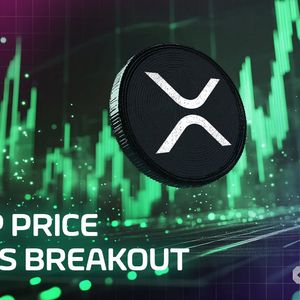Mantra’s decentralized finance protocol has experienced a dramatic week marked by a sharp 90% drop in the price of its OM token, a subsequent 500% surge in total value locked (TVL), and a bold proposal from CEO John Mullin to burn the team’s token allocation. The developments have sparked heated debate within the crypto community over the platform’s future, capital efficiency, and the implications of concentrated liquidity amid volatile market conditions. Mantra CEO Proposes Burning Team Tokens Amid Community Outcry Over $5.5B Token Crash John Mullin, the CEO of Mantra , has taken a dramatic step in response to the massive collapse of the platform’s native token, OM, pledging to burn the entire allocation of team tokens to regain the trust of the shaken community. The move comes just days after OM plummeted from around $6.30 to a low of $0.52 on April 13, wiping over $5.5 billion in market capitalization in a matter of hours. Mantra price chart (Source: CoinMarketCap) “I’m planning to burn all of my team tokens and when we turn it around the community and investors can decide if I have earned it back,” Mullin posted to X on April 16. $236 Million in Team Tokens on the Line According to Mantra's April 8 blog post , the project had earmarked 300 million OM—roughly 16.88% of its nearly 1.78 billion total supply—for the team and core contributors. These tokens, locked until between April 2027 and October 2029, were intended to serve as a long-term incentive for Mantra’s builders. Before the April 13 crash, these tokens were valued at around $1.89 billion. At current prices, their worth has plummeted to approximately $236 million. Mullin’s pledge has stirred mixed reactions across the crypto space. While some community members see the gesture as a powerful sign of accountability, others worry it could demotivate the very team tasked with rebuilding Mantra’s reputation and platform. “This would be a mistake. We want teams that are highly incentivized. Burning the incentive may seem like a good gesture but it will hurt the team motivation long term,” said Ran Neuner, founder of Crypto Banter. In response to the debate, Mullin floated the idea of initiating a decentralized community vote to determine whether the burn should proceed. The sudden nosedive in OM’s price on April 13 sent shockwaves through the digital asset world. OM plunged from over $6.30 to as low as $0.52 in a single day, triggering a cascade of liquidations and erasing billions in market value. CoinGecko data confirms the rapid devaluation, sparking suspicions of insider activity, manipulation, or structural flaws in Mantra’s tokenomics. Mantra has strongly denied any allegations of market manipulation or internal wrongdoing. Mullin said on April 14 that the price collapse stemmed from “reckless liquidations” and was unrelated to any actions taken by the project’s team. Still, major centralized exchanges like OKX and Binance saw heavy OM trading volumes just before the crash, prompting scrutiny of their role in the meltdown. Both OKX and Binance denied any culpability, citing OM’s previously implemented tokenomics changes and market volatility as the likely causes. These shifts, made back in October, apparently contributed to a wave of cross-exchange liquidations on April 13 that overwhelmed market depth and liquidity. The Road to Recovery Despite the chaos, Mullin emphasized that a recovery plan is already underway. Mantra intends to leverage its $109 million Ecosystem Fund to stabilize OM’s price. This may include strategic token buybacks and additional burns, as well as support initiatives to incentivize continued developer and user engagement on the Mantra platform. A full post-mortem report is expected soon, as Mullin and his team work to provide a detailed breakdown of the events leading to the collapse. Transparency, he noted, is key to restoring confidence among users and investors alike. The proposal to burn team tokens is not just a symbolic gesture—it reflects a broader push toward community-led governance in the wake of crisis. Mullin’s openness to a decentralized vote signals a pivot to greater user control over the platform’s future direction. As of now, OM remains under pressure, hovering well below its pre-collapse highs. Yet, the story of Mantra is far from over. Whether Mullin’s drastic proposal will inspire renewed trust or provoke deeper divisions remains to be seen—but the move undeniably sets a precedent for how crypto project leaders might respond when the community’s faith is shaken. Mantra TVL Soars 500% Despite 90% OM Price Crash, Raising Eyebrows in DeFi Circles In a surprising twist of DeFi dynamics, the total value locked (TVL) in the Mantra ecosystem surged over 500% just days after the catastrophic price collapse of its native token, OM. The contradictory signals—plummeting token value and rising user engagement—have sparked a wave of speculation about whether whales, insiders, or opportunistic DeFi participants are positioning for a potential rebound. According to DefiLlama , Mantra’s TVL hit 4.21 million OM on April 15—equivalent to approximately $3.24 million based on prevailing market prices—representing a fivefold increase from just two days prior. This rise came immediately after OM lost more than 90% of its value in a matter of hours, falling from $6.30 to $0.52 on April 13. Mantra’s cumulative TVL chart (Source: DefiLlama) The Mantra team has attributed OM’s price collapse to “reckless forced liquidations” on centralized exchanges. However, on-chain analysts saw a different pattern emerging during the carnage. DOM, a well-known crypto market observer, flagged “aggressive buying” behavior worth over $35 million during the steep selloff. The timing of these purchases has fueled speculation that large buyers—whether savvy traders, institutional players, or insiders—viewed the crash as a deep-discount entry point. This aggressive accumulation—combined with a rebound in OM's price to nearly $0.99 on April 15, a 170% jump from the weekend low—suggests that not everyone viewed the crash as a death spiral. Some evidently saw it as an opportunity to farm incentives, earn governance rights, or speculate on an eventual recovery. While the rising TVL may seem like a sign of strength, closer inspection raises concerns. An overwhelming 97% of Mantra’s TVL is concentrated in a single application: Mantra Swap, the protocol’s native decentralized exchange. Automated market-making (AMM) pools on Mantra Swap now hold over 4.11 million OM, making it the sole contributor to Mantra’s recent TVL rise. This level of concentration is uncommon in mature DeFi ecosystems, where capital is typically distributed across multiple services such as lending platforms, staking protocols, insurance markets, and derivatives. The lopsided nature of Mantra’s capital deployment suggests the ecosystem lacks depth, diversity, and long-term resilience. Valuation Discrepancy Raises Alarm Bells Perhaps the most concerning indicator is the yawning chasm between Mantra’s fully diluted valuation (FDV) and its TVL. As of April 15, Mantra's FDV sat at approximately $1.88 billion, while its actual locked value remained at just $3.24 million. This means less than 0.17% of its theoretical value is actively deployed in the protocol. Such a discrepancy points to poor capital efficiency and hints that OM’s valuation may be more speculative than grounded in real usage. With much of OM’s token supply still locked and scheduled to vest over the coming years, the potential for future dilution adds further risk for current investors. Crypto analyst JamesBitunix warned that the sharp bounce in OM might only be temporary, driven by short-term speculation rather than sustainable fundamentals. What Comes Next for Mantra? Despite its soaring TVL, Mantra remains under intense scrutiny. The project’s leadership has denied accusations of insider trading or manipulation and has promised a detailed post-mortem to clarify what triggered OM’s historic crash. CEO John Mullin has even offered to burn the entire team’s token allocation—worth over $236 million—to regain the community’s trust. The TVL spike offers a rare glimmer of optimism, but without more decentralized adoption, sustainable development, and real-world use cases, Mantra may face a steep climb to rebuild credibility. Whether this is the beginning of a genuine rebound or a brief speculative blip remains uncertain.


















